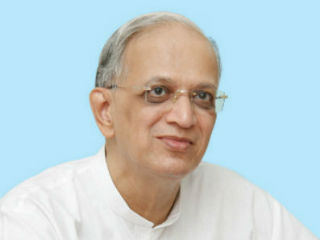 As of now, there are many established Paths of Yoga (Spiritual practice) such as Dnyanyoga (Path of knowledge), Karmayoga (Path of action), Bhaktiyoga (Path of devotion), Dhyanyoga (Path of meditation), Hathayoga (Path of deliberate rigour), Namsankirtanyoga (Path of chanting the Name [of God]), Kundaliniyoga (Path of activation of spiritual energy), Shaktipatyoga (Path of self-realisation by transmission of spiritual energy from the Guru) etc. By the grace of Saint Bhaktaraj Maharaj – The seat of faith of Sanatan Sanstha – Paratpar Guru (Dr.) Athavale (Inspiration for Sanatan Sanstha) propounded Gurukrupayoga (Path of Guru’s grace) in 1994. Given ahead is the Divine knowledge obtained by Mr. Ram Honap pertaining to this Path of sadhana (Spiritual practice). In subsequent issues we will provide knowledge pertaining to this Path of sadhana obtained by Mr. Nishad Deshmukh and Ms. Madhura Bhosale.
As of now, there are many established Paths of Yoga (Spiritual practice) such as Dnyanyoga (Path of knowledge), Karmayoga (Path of action), Bhaktiyoga (Path of devotion), Dhyanyoga (Path of meditation), Hathayoga (Path of deliberate rigour), Namsankirtanyoga (Path of chanting the Name [of God]), Kundaliniyoga (Path of activation of spiritual energy), Shaktipatyoga (Path of self-realisation by transmission of spiritual energy from the Guru) etc. By the grace of Saint Bhaktaraj Maharaj – The seat of faith of Sanatan Sanstha – Paratpar Guru (Dr.) Athavale (Inspiration for Sanatan Sanstha) propounded Gurukrupayoga (Path of Guru’s grace) in 1994. Given ahead is the Divine knowledge obtained by Mr. Ram Honap pertaining to this Path of sadhana (Spiritual practice). In subsequent issues we will provide knowledge pertaining to this Path of sadhana obtained by Mr. Nishad Deshmukh and Ms. Madhura Bhosale.
Gurukrupayoga – A Path for faster spiritual progress
1. The spiritual uniqueness of Gurukrupayoga when
compared with other Paths of sadhana (Spiritual practice)
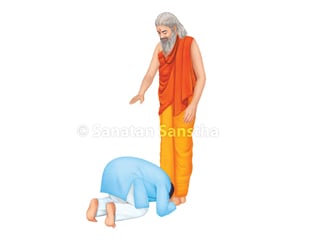 1A. Other Paths of sadhana and Gurukrupayoga
1A. Other Paths of sadhana and Gurukrupayoga
‘Dnyanyoga, Dhyanyoga, Bhaktiyoga and Karmayoga are all Paths of God-realisation. Gurukrupayoga incorporates all these Paths and yet it is different. Given ahead is a comparative study.
1A 1. Karmayoga
In this Path, utmost importance is given to karma (An act which gives rise to destiny). Only if a karma is flawless and complete in all respects, it yields the desired fruit. If there are flaws in performing karma, sadhana gets wasted.
1A 1A. Karmayoga within Gurukrupayoga
In Karmayoga, besides performing karma in a flawless manner, it is important that it be performed with bhav (Spiritual emotion). As a result, God forgives the seeker for the mistakes made by him knowingly or unknowingly. Besides, the seeker expresses gratitude while performing karma. In such a karma, the seeker has less ego and as a result, the extent of karmadosha (Demerit resulting from a flawed karma) to the seeker is minimal.
Karmayoga lays emphasis on excellence in performing karma. In Karmayoga within Gurukrupayoga, a seeker is taught to study the thoughts arising while performing the karma. As a result, the karma gets purified at the gross as well as subtle level. This culminates in a superior reward to the seeker from the perspective of sadhana.
1A 2. Bhaktiyoga
In Bhaktiyoga, more importance is given to aspects such as the Idol of a Deity, its form, virtues, remembrance and the love for the Deity. All these aspects are associated with the Deity and the devotee.
1A 2A. Bhaktiyoga within Gurukrupayoga
In Bhaktiyoga within Gurukrupayoga a seeker is consistently taught how to see God in every incident, living as well as non-living beings, how to worship Him. As a result, the seeker does not have a narrow-minded approach of ‘me and God’ as in Bhaktiyoga; instead, while performing sadhana as per Gurukrupayoga, the seeker increasingly becomes aware about the omnipresence of God. This further leads to fast reduction of his ego and he makes fast spiritual progress as well.
1A 3. Dhyanyoga
In Dhyanyoga, the mind of a seeker has to remain steady while performing sadhana. With increased level of Raja-Tama components in the present times it is difficult to perform sadhana according to Dhyanyoga; besides, this Path requires sitting in one place for hours at a stretch and it places certain physical limitations.
1A 3A. Dhyanyoga within Guru-krupayoga
The seeker lays emphasis on chanting God’s Name consistently. As a result, he is able to concentrate quickly. The seeker is engrossed in performing flawless seva with bhav. While performing the karma of seva, he is alert to performing the seva in a flawless manner. This is the unexpressed bhav of the seeker towards seva. The seeker getting completely engrossed in the seva is a sign of effortless meditative state.
Once the seeker begins to merge with the seva he is performing, he slowly begins to march towards the effortless meditative state. This is the final stage of Dhyanyoga. During normal meditation, concentration is difficult to acheive. In comparison, concentration is attained quickly during seva. Hence, the seeker attains the meditative state quickly through the medium of seva.
1A 4. Dnyanyoga
To perform sadhana according to Dnyanyoga, one needs to have a high spiritual level. Since the jivas (Embodied souls) in Kaliyug perform very little sadhana, they are unable to consistently follow Dnyanyoga. Consequently, the seeker takes a lot of time to progress spiritually on this Path.
1A 4A. Dnyanyoga within Gurukrupayoga
Knowledge is infinite and whatever be the extent of knowledge we obtain, it is still very little. Human life has limitations. Hence, in Gurukrupayoga, a seeker is imparted knowledge necessary for God-realisation as per Dnyanyoga through the medium of satsang (A Holy gathering) or Holy texts.
Here, importance is given to saving time that would be otherwise wasted in obtaining knowledge that is not useful, and utilising that time for actually performing sadhana and thereby, attain the state of God-realisation. Hence, a seeker who follows Gurukrupayoga puts into practice whatever knowledge he obtains, and as a result, progresses faster spiritually.
1B. Comparison of other unique features of Gurukrupayoga
1B 1. Gurukrupayoga gives importance to all the Paths of Yoga
Dnyanyoga lays emphasis on obtaining knowledge, Dhyanyoga on meditation, Bhaktiyoga on devotion and Karmayoga on karma; conversely, Guru-krupayoga lays emphasis on all these Yogas.
1B 2. Performing samashti sadhana (Sadhana for the sake of society) helps in early repayment of debt unto society
For attaining Moksha (Final Liberation), it is necessary to repay Matru-Pitrurhun (Debt unto mother-father), Devarhun (Debt unto Deities), Rushirhun (Debt unto Sages) and Samajrhun (Debt unto the society). In other Paths of Yoga, the first three debts are repaid through the vyashti (Individual) sadhana performed by the individual; however, not Samajrhun; for, this debt can be repaid only through the spread of Spirituality. Sadhana performed according to Gurukrupayoga gives 70% importance to samashti sadhana. As a result, the seeker is freed of all the four debts.
1B 3. Practical guidance on elimination of obstacles in sadhana
Other Paths of Yoga do show the way to God-realisation; however, the method of eliminating obstacles of personality defects and ego while treading these Paths has been shown only by Gurukrupayoga.
1B 4. Laying emphasis on tarak (Saviour) and marak (Destroyer) worship
Other Paths of Yoga lay emphasis on the tarak worship of God. Gurukrupayoga lays emphasis on tarak as well as marak worship of God. Both these are very much forms of God, and hence, worship through both these mediums helps the seeker reach God faster.
1B 5. The seeker remains connected with the Guru Principle through the medium of ashtangsadhana (Eight- fold spiritual practice) and hence, requires no guidance from the Guru in the gross form
While performing sadhana according to other Paths, the seeker needs a Guru in the gross form at every stage. Gurukrupayoga advises ashtangsadhana. If the seeker sincerely performs sadhana according to this, he gets directly connected with the Guru Principle. Thereafter, the Guru Principle guides him at every stage through the subtle medium or through some other gross medium and takes him upto Moksha. This process itself is called ‘Gurukrupayoga’.
1B 6. Growth of Divine virtues of Priti (Love without expectations) and expansiveness in the seeker
Other Paths of Yoga do not lay emphasis on samashti sadhana; whereas, Gurukrupayoga lays greater emphasis on samashti sadhana. Encouraging the society to perform sadhana, meaning, consistently thinking about others results in the development of Divine virtues of Priti and expansiveness in the seeker.
1B 7. The spiritual level necessary to perform sadhana according to various Paths of Yoga
| Path of Yoga | Spiritual level necessary to perform sadhana (%) |
| 1. Dnyanyoga | 50 |
| 2. Dhyanyoga | 50 |
| 3. Bhaktiyoga | 40 |
| 4. Karmayoga | 40 |
| 5. Gurukrupayoga | 35 |
In Kaliyug, the spiritual level of a common man is 20%. Therefore, when compared with the other Paths of Yoga, he finds it easier to perform sadhana according to Gurukrupayoga. This can be understood from the above table. So also, if jivas whose spiritual level is low, moderate or high perform sadhana according to Gurukrupayoga, they make faster spiritual progress.
1B 8. When compared with other Paths of Yoga, the steps in God-realisation are defined in detail in Gurukrupayoga
Knowledge about aspects such as ‘How to move ahead while performing sadhana ? What are the various stages in sadhana ? How to eliminate various obstacles faced on the way ?’ is limited in other Paths of Yoga. In Gurukrupayoga guidance about these aspects is provided in detail. As a result treading the path of attaining Moksha becomes easier.
1C. The propoportion of Pranashakti (Vital energy) necessary for the functioning of different subtle bodies and ego
| Subtle body and ego | The proportion of Pranashakti necessary for functioning |
| 1. Sthuladeha (Gross body) | 05 |
| 2. Manodeha (Mind) | 10 |
| 3. Karandeha (Causal body) | 20 |
| 4. Mahakarandeha (Supracausal body or Chitta) |
30 |
| 5. Ego | 35 |
| Total | 100 |
According to this table, the extent of Pranashakti utilised on the chitta (Subconscious mind [which has various personality defects]) and ego is 65%. In Gurukrupayoga, 60% importance is given to the process of personality defect removal. When this process is implemented, a large part of the seeker’s Pranashakti that otherwise gets wasted is saved and is utilised for spiritual progress.
1D. In attaining Moksha, purification of the chitta has utmost importance
Irrespective of the Path of Yoga, unless the chitta is purified, meaning, personality defects and ego are eliminated, God-realisation is not possible. This aspect is not given much importance in other Paths of Yoga, and hence, a large part of a seeker’s sadhana is utilised for the purification of the chitta.
1E. The importance of Gurukrupayoga as per the times
Taking into consideration the Raja-Tama predominant environment in the Kaliyug, the capacity of human beings to perform sadhana and their lifespan, Gurukrupayoga is the Path that bestows the fruit of sadhana quickly; because, Gurukrupayoga has been created by God as per the need of the times.
1F. The level of difficulty and the gains of Guru-krupayoga
When compared with other Paths of Yoga, Gurukrupayoga is the most difficult; because, while performing sadhana according to other Paths of Yoga, a seeker does not come in contact with other seekers or the society; however, Gurukrupayoga lays more emphasis on samashti sadhana. Hence, on this Path, a seeker always comes in contact with other seekers or the society.
At such times, the seeker finds it difficult to perform sadhana while adjusting to people of different temperaments. In doing this, the seeker faces a lot of resistance from his own mind. As his spiritual practice increases, the resistance of his mind reduces. Thereafter, as the consequence of overcoming this resistance, his path to Moksha becomes easy.
1G. The foundation of Gurukrupayoga was laid in the past births of Paratpar Guru (Dr.) Athavale
Paratpar Guru (Dr.) Athavale has performed sadhana according to Dnyanyoga, Dhyanyoga, Bhaktiyoga and Karmayoga in His past births, meaning, He has studied and practiced these Paths in His past births. Hence, in this birth He could propound Gurukrupayoga, a Path of sadhana that strikes an appropriate balance between all the four Paths of Yoga.
1H. The reasons why Paratpar Guru (Dr.) Athavale could propound Gurukrupayoga and their extent
| The reasons for being able to propound Gurukrupayoga | Extent (%) |
| 1. The experience of different Paths of Yoga in the past births | 30 |
| 2. Divine Knowledge obtained in the meditative state in the present birth | 30 |
| 3. Reincarnate mission | 35 |
| 4. Other | 05 |
| Total | 100 |
– Mr. Ram Honap (Knowledge obtained from the subtle dimension), Sanatan Ashram, Ramnathi, Goa.
Subtle : That which is beyond the comprehension of the five sense organs, mind and intellect is called ‘subtle’. Individuals who have progressed spiritually are able to comprehend subtle sensations. ‘Subtle knowledge’ finds extensive mention in our various Scriptures.
2. The concept underlying Paratpar Guru (Dr.) Athavale’s thought of propounding Gurukrupayoga
2A. Saints
2A 1. The Gurutattva (The Guru Principle) educating on various aspects of Dnyan (Knowledge), Bhakti (Devotion) and Karma (Action which gives rise to destiny)
Due to Paratpar Guru (Dr.) Athavale’s yearning, the Gurutattva imparted Him knowledge on Dnyanyoga, Bhaktiyoga, Karmayoga and the other practical aspects of spiritual practice.
2A 2. The Paths of Yoga and subjects taught by various Saints to Paratpar Guru (Dr.) Athavale
Saint The Path of Yoga The subject
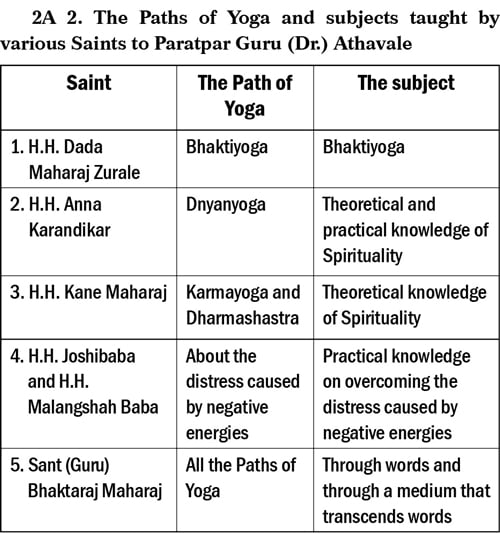
1. H.H. Dada Maharaj Zurale Bhaktiyoga Bhaktiyoga
2. H.H. Anna Karandikar Dnyanyoga Theoretical and practical knowledge of Spirituality
3. H.H. Kane Maharaj Karmayoga and Dharmashastra Theoretical knowledge of Spirituality
4. H.H. Joshibaba and H.H. Malangshah Baba About the distress caused by negative energies Practical knowledge on overcoming the distress caused by negative energies
5. Sant (Guru) Bhaktaraj Maharaj All the Paths of Yoga Through words and through a medium that transcends words
2A 3. Presenting the teachings of Saints in scientific terminology
Paratpar Guru (Dr.) Athavale compiled the knowledge He obtained from various Saints and presented it in a spiritual terminology. In 1987, Paratpar Guru (Dr.) Athavale published His first cyclostyled Holy text titles ‘Spirituality’. After publishing this Holy text, He commenced His march towards samashti Dnyanyoga.
2B. Sant Bhaktaraj Maharaj – Paratpar Guru (Dr.) Athavale’s Guru
2B 1. Sant Bhaktaraj Maharaj made Paratpar Guru (Dr.) Athavale perform sadhana that strikes a balance between Dnyan, Bhakti and Karma, due to which He became a Saint in just 1½ years
Other Saints gave Paratpar Guru (Dr.) Athavale knowledge in words about spiritual practice, whereas Sant Bhaktaraj Maharaj made Paratpar Guru (Dr.) Athavale perform sadhana that struck a balance between Dnyan, Bhakti and Karma. As a result of this sadhana, Paratpar Guru (Dr.) Athavale obtained knowledge that transcended words. It was because of this balance between Dnyan, Bhakti and Karma while performing sadhana, that Paratpar Guru (Dr.) Athavale progressed to the level of a Saint from the level of a disciple in a short span of 1½ years.
2B 2. Sant Bhaktaraj Maharaj gave Paratpar Guru (Dr.) Athavale authority over Dnyanyoga, Bhaktiyoga and Karmayoga
Generally a Guru gives a disciple authority on only one Path of Yoga. It is because of this authority, that the disciple advises the samashti about the associated Path of Yoga and thereby completes his vyashti sadhana. In 1993, Sant Bhaktaraj Maharaj blessed Paratpar Guru (Dr.) Athavale with Dnyan (Knowledge), Bhakti (Devotion) and Vairagya (Detachment). Through this medium, He gave Paratpar Guru (Dr.) Athavale authority over Dnyanyoga, Bhaktiyoga and Karmayoga. As a result, Paratpar Guru (Dr.) Athavale developed the ability to guide the followers of all Paths of Yoga.
2B 3. Sant Bhaktaraj Maharaj asking Paratpar Guru (Dr.) Athavale to propagate Spirituality throughout the world
2B 3A. Premonition about Jagadguru status
In 1987-88, a tantrik (Practitioner of tantra [A Path of spiritual practice]) used to teach spiritual practice to Paratpar Guru (Dr.) Athavale every day. Once he asked Paratpar Guru (Dr.) Athavale, “What do you see in the meditative state ?” Paratpar Guru (Dr.) Athavale replied that He sees a throne with ‘? (Om)’ written on it. Upon this, the tantrik said, “You have to occupy this throne in the future”.
2B 3B. Spiritual experience
A lady-devotee of Sant (Guru) Bhaktaraj Maharaj was in distress and she fell asleep praying to Him. In the night, Sant Bhaktaraj Maharaj came in her dreams and said to her, “Do not pray to me now. Pray instead to my disciple (Paratpar Guru [Dr.] Athavale)”. (Reference of the premonition and the spiritual experience : Sanatan’s Holy text – ‘Gurukrupayoga’, 1st Edition.)
2B 4. Reason for referring to Paratpar Guru (Dr.) Athavale as He is Vishwaguru in the Dnyan obtained
2B 4A. Vishwaguru – One who performs a mission which affects the universe that has countless worlds
God created the universe. There are innumerable creations within this Creation. Our earth is one such Creation. Each Creation has a different time period in operation at any given time. Some are being created, whereas, some other are in the process of Dissolution. A Guru who takes up a mission that is conducive to all the Creations is called a ‘Vishwaguru’ or ‘Jagadguru’.
2B 4B. Since the mission of other Gurus who exist in body-form is at the sagun level, it has limitations
Gurus who exist in the body-form carry on their mission as per the guidance of the Gurutattva. As a result, their mission is at the sagun level and is limited to the current period of one Creation and the gross as well as the subtle world associated with that Creation. Their mission does not have any effect on the existence of the infinite world. As a result, they are not able to guide their devotees after a few thousand years; so also, the knowledge they impart is associated with the current time and the devotees associated with this time. Hence, it is not beneficial to the jivas (Embodied souls) for their spiritual progress in future.
2B 4C. Unique features of the mission of Vishwaguru or Jagadguru
The mission of Vishwaguru or Jagadguru is not bound by the limitations of place. Hence, the knowledge that materialises from the nirgun as a result of their mission, impacts the world. It is because of Vishwaguru that knowledge conducive to the samashti manifests from the nirgun into the sagun. Therefore, when the jivas that have taken birth in the current Creation, take birth in another Creation as per the prevailing times, they teach the other jivas samashti knowledge. Guidance provided by Vishwaguru or Jagadguru is the guiding force to the jivas in this infinite Creation, such as the guidance of Shrikrushna through the medium of Shrimadbhagwadgeeta.
2B 4D. The mission of Paratpar Guru (Dr.) Athavale is impacting the entire universe
In the form of Gurukrupayoga, Paratpar Guru (Dr.) Athavale has performed the mission of providing the society with knowledge pertaining to samashti sadhana – sadhana as per the prakruti (Basic nature) and changing the prakruti. This mission has impacted the entire world, and hence, Paratpar Guru (Dr.) Athavale is called a Vishwaguru of the respective times in the knowledge obtained.’
– Mr. Nishad Deshmukh (Knowledge obtained through the subtle dimension), Sanatan Ashram, Ramnathi, Goa. (4.12.2017, 1.10 p.m.)
2B 4E. Difference between Vishwaguru or Jagadguru
One who guides the whole world is a Vishwaguru. The mission of a Vishwaguru is for a specified period. Conversely, one who takes up a mission that transcends place and time, is helpful to the samashti for a long time or is beneficial for sadhana of the jiva of subsequent births and also provides guidance is a Paratpar Guru.
2B 4F. God creating Gurukrupayoga through the medium of Paratpar Guru (Dr.) Athavale since He is a Vishwaguru and has authority over Dnyan, Bhakti and Karma
It is because of His authority over Dnyanyoga, Bhaktiyoga and Karmayoga as well as the fact that He is a Vishwaguru, that God made Paratpar Guru (Dr.) Athavale the medium to create Gurukrupayoga. Hence, as per God’s wish, Paratpar Guru (Dr.) Athavale had thoughts about Gurukrupayoga. Knowledge about the practical aspects of different Paths of Yoga and their limitations resulted in creation of Gurukrupayoga (by Paratpar Guru [Dr.] Athavale), which guides on spiritual progress by striking a balance between Dnyan, Bhakti and Karma.
2C. The stages in the process of Paratpar Guru (Dr.) Athavale propounding the concept of Gurukrupayoga
2C 1. Paratpar Guru (Dr.) Athavale’s thoughtless state of mind and intellect
Even in a state of natural state of communion with God, Paratpar Guru (Dr.) Athavale’s mind and body would merge with the Universal mind and Universal intellect because of His samashti sadhana (Spiritual practice for the welfare of the society). In this period, His mind and intellect would be in a thoughtless state. In this state, He would obtain subtle knowledge pertaining to Gurukrupayoga.
2C 2. Upon examining the state of many jivas, the mind and intellect comprehending knowledge in the subconscious mind in the form of thoughts
During the propagation of Spirituality in the society, as per the law of image and reflection Paratpar Guru (Dr.) Athavale would be able to understand the state of sadhana of a jiva who was stagnating in sadhana. His mind and intellect would then comprehend the solution in the form of thoughts to the difficulty being faced by the seeker in his sadhana from the knowledge in his subconscious mind. These thoughts are about the laws, principles and the mistakes to be avoided as per sadhana according to Gurukrupayoga.
2C 3. A jiva getting proof upon being guided as per the laws, principles and the mistakes to be avoided
Upon guiding a jiva as per the laws, principles and the mistakes to be avoided as per Gurukrupayoga, changes would be noticed in the jiva in a short period. This proved the practical importance of the laws, principles and the mistakes to be avoided as per Gurukrupayoga and as a result each of these parts were created.
2C 4. Paratpar Guru (Dr.) Athavale is a research-oriented individual by nature, and hence, Gurukrupayoga was created in a scientific manner and will help crores of jivas till the end of Kaliyug
Every behaviour, action, law and principle created by God is spiritually perfect from the physical, psychological and spiritual perspective. The capability of a jiva has reduced as per the significance of time, and as a result, the perfection in behaviour too is declining. Paratpar Guru (Dr.) Athavale is a research-oriented individual by nature, and hence, crores of jivas will benefit from Gurukrupayoga till the end of Kaliyug
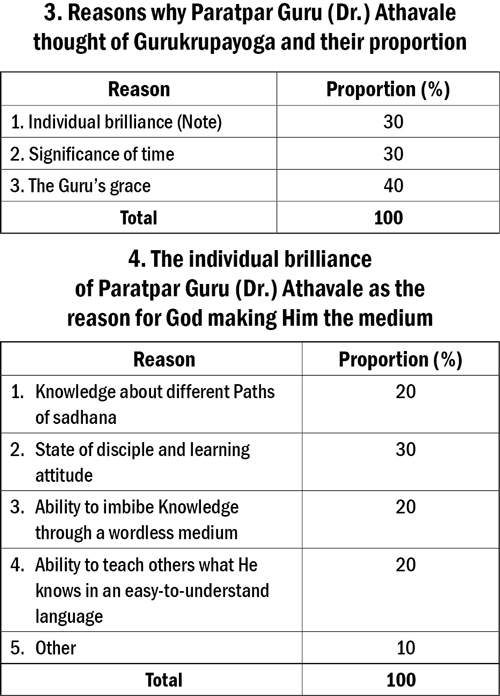
5. The importance of Gurukrupayoga when compared with other Paths of Yoga and its unique features
5A. All encompassing
Most jivas that get attracted to sadhana have a subtle sanskar (Subconscious impression) of sadhana according to some or the other Path of Yoga on their minds. Other Paths of Yoga pursue only one aspect of sadhana. Hence, only a few people get attracted to that Path of Yoga. Conversely, Gurukrupayoga incorporates all the Paths of Yoga. Therefore, irrespective of the Path of Yoga according to which a jiva is performing sadhana, it can still accept very easily the laws, principles and practical aspects of Gurukrupayoga and perform sadhana.
5B. Balancing of pravrutti and nivrutti
Other Paths of Yoga are either pravrutti-predominant (Inclination towards participation in worldly affairs) or nivrutti-predominant (Inclination towards cessation of participation in worldly affairs). As a result, a jiva has to take birth in the bhog-yoni (Species that assumes a gross body for undergoing destiny or worldly pleasures) or there is a possibility of it getting trapped in the cycles of birth-and-death because of its give-and-take account. Contrary to this, there is a balance of pravrutti and nivrutti in Gurukrupayoga. Hence, even if a jiva is treading the Path of nivrutti, since it fulfils its duty-related karma, which does not get transformed into accumulated prarabdha or samashti prarabdha. Besides, though it appears physically that the jiva is treading the Path of pravrutti, it treads the Path of nivrutti mentally. As a result, whatever karma it does in worldly life is performed as sadhana, due to which no new give-and-take account is created.
5C. Teaching samashti sadhana along with vyashti sadhana
In other Paths of Yoga, jivas are first asked to complete their vyashti sadhana and only then their samashti sadhana commences. A jiva has to take many births in this process. Conversely, vyashti as well as samashti sadhana is taught in Gurukrupayoga. This saves the jiva’s invaluable time and makes it progress faster spiritually.
5D. Teaching the practical aspects of sadhana
In other Paths of Yoga, there is more of theoretical knowledge, which is associated with Dnyanshakti (Energy of knowledge). As a result, jivas that have less sattvikata fail to understand the principle in the Path of Yoga. When jivas perform sadhana for long periods with faith, their sattvikata increases. Thus, they understand the theoretical aspect of the Path of Yoga and are able to act accordingly.
5E. Creating the sanskar of sadhana on the subconscious mind of the jiva
The constitution of other Paths of Yoga is not conducive to the prakruti (Basic nature) of a jiva. As a result, while performing sadhana according to other Paths of Yoga a jiva has to make changes in its prakruti. In this process, the jiva faces a lot of resistance and as a result, the sanskars of sadhana are not created adequately on the subconscious mind of the jiva. Conversely, in Gurukrupayoga, the sadhana is conducive to the prakruti of the jiva and results in creation of a strong sanskar of sadhana on its subconscious mind. Due to the strong sanskar of sadhana on its subconscious mind, the jiva’s sadhana continues in superior regions after its death.
5F. Getting sadhana performed through the sufferings due to prarabdha
The other Paths of Yoga do not advise how to perform sadhana during the adverse times. If the spiritual level of the seeker is high, it can implement the principles of sadhana and continue with sadhana even while undergoing sufferings due to prarabdha. Conversely, in Gurukrupayoga, a jiva is taught to undergo the sufferings due to prarabdha as a part of sadhana. As a result, even while undergoing sufferings due to prarabdha, the sadhana of the jiva is not interrupted but continues unhindered.
5G. Teaching sadhana as one progresses
To attain Moksha (The Final Liberation) a jiva has to perform sadhana according to each of the three Paths – Dnyanyoga, Bhaktiyoga and Karmayoga. Most of the jivas complete vyashti sadhana by treading one Path of Yoga, and to complete their sadhana, they perform sadhana according to other Paths as they progress spiritually. As they tread one Path of Yoga, they complete their sadhana treading the same Path, such as a jiva treading the Path of Dnyanyoga for vyashti sadhana performing Dnyanottar-bhakti (Devotion upon obtaining knowledge) and Dnyanottar-karma (Karma upon obtaining knowledge). Conversely, Gurukrupayoga strikes a balance between Dnyan, Bhakti and Karma. As a result, a jiva treading the Path of Gurukrupayoga is not required to perform different types of sadhana upon progressing spiritually. Besides, jivas whose sadhana upon progressing spiritually is due, perform sadhana according to Path of Gurukrupayoga, they progress faster spiritually.
5H. A faster path of sadhana
In other Paths of Yoga, the awakening of the Kundalini chakras takes place one-by-one. Conversely, Gurukrupayoga is a faster path of sadhana, and hence, awakening of the chakras follows the sequence of Muladhar-Manipur-Anahat and Adnya. Therefore, awakening of the chakras in a jiva gets completed quickly.
A faster path of sadhana is predominantly Vayutattava-related. Hence, it enables significant emission-related activity with the help of energy of bhav (Spiritual emotion) from the Anahat-chakra. Gurukrupayoga primarily incorporates samashti, and hence, one can progress faster spiritually. (Sanatan Sanstha teaches sadhana as per Gurukrupayoga. – Compiler)’
(Knowledge received through the medium of Sadguru [Mrs.] Anjali Gadgil, 3.6.2006, 1.33 p.m.) (Reference : Sanatan’s Holy text – ‘Spiritual practice’)
5I. Merging the jiva with the Guru Principle
While performing sadhana as per other Paths of Yoga, a jiva merges either with nirgun (Non-materialised) God Principle or sagun (Materialised) God Principle; for example, an individual treading the Path of Dnyanyoga merges with God which is beyond words; an individual treading the Path of Bhaktiyoga merges with the abode, form, virtues and company of the Upasyadevata (Deity of worship); an individual treading the Path of Karmayoga merges with nishkam karma (Karma performed without expectation) and an individual treading Path of Namsankirtanyoga (Path of chanting) merges with the Name. Since all the Paths of Yoga are one-dimensional, the jiva merges with only that particular form of God associated with the Path of Yoga he selects. Hence, there is likelihood of the jiva taking rebirths.
Conversely, in Gurukrupayoga, a jiva performs eightfold sadhana, and hence, merges directly with the Guru Principle. The Guru Principle incorporates all the Principles, and hence, the jiva attains Moksha. Consequently, it has no more births; for example Sant Bhaktaraj Maharaj. ?
– Mr. Nishad Deshmukh (Knowledge obtained through the subtle dimension), Sanatan Ashram, Ramnathi, Goa. (4.12.2017)

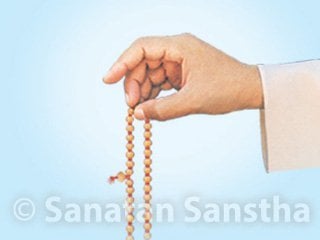 Why do we chant Name of Kuladevi instead of Kuladev?
Why do we chant Name of Kuladevi instead of Kuladev? Remedies for mental illness arising in an emergency
Remedies for mental illness arising in an emergency how to improve mental strength to face a terrible situation such as a riot
how to improve mental strength to face a terrible situation such as a riot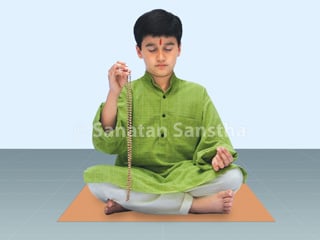 Guidance by His Holiness Bhagwantkumar Menrai on how to coordinate chanting the Name of God...
Guidance by His Holiness Bhagwantkumar Menrai on how to coordinate chanting the Name of God...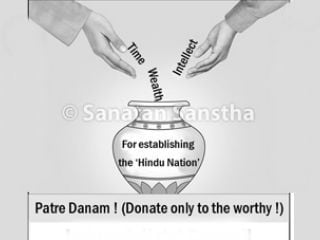 Difference between donation and offering and their importance
Difference between donation and offering and their importance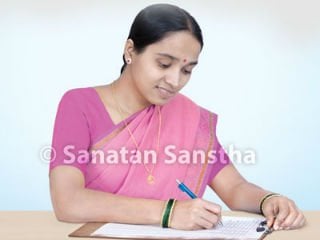 Do not feel scared by the increasing coronavirus outbreak all over and strengthen your inner-self...
Do not feel scared by the increasing coronavirus outbreak all over and strengthen your inner-self...